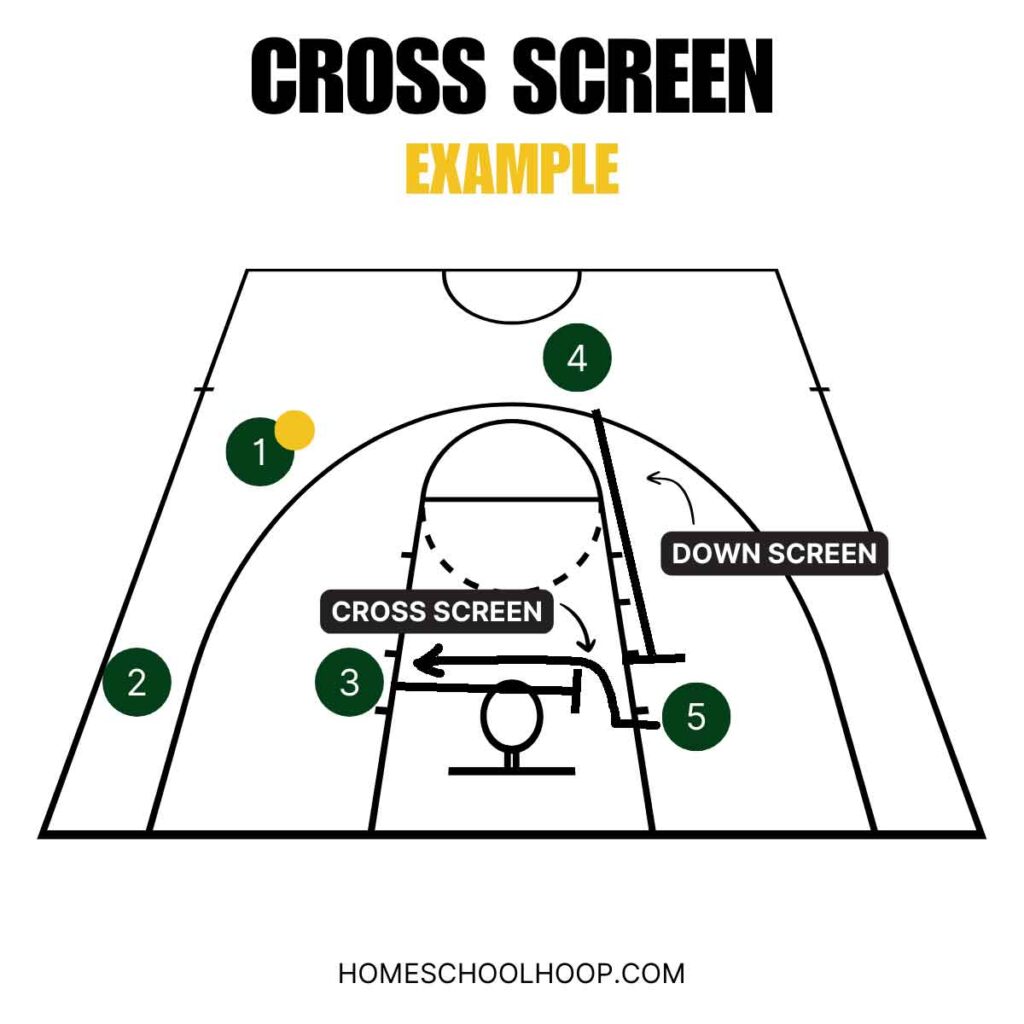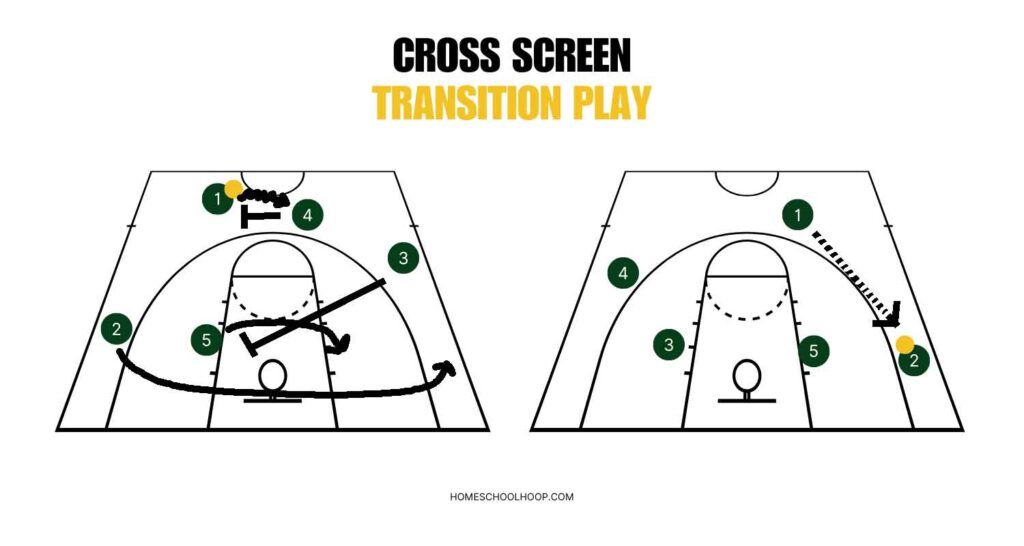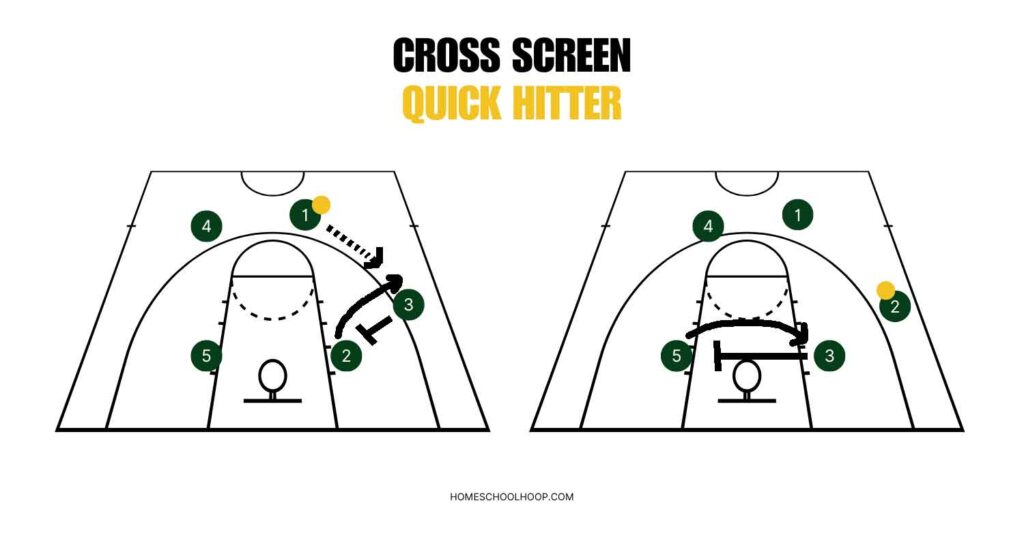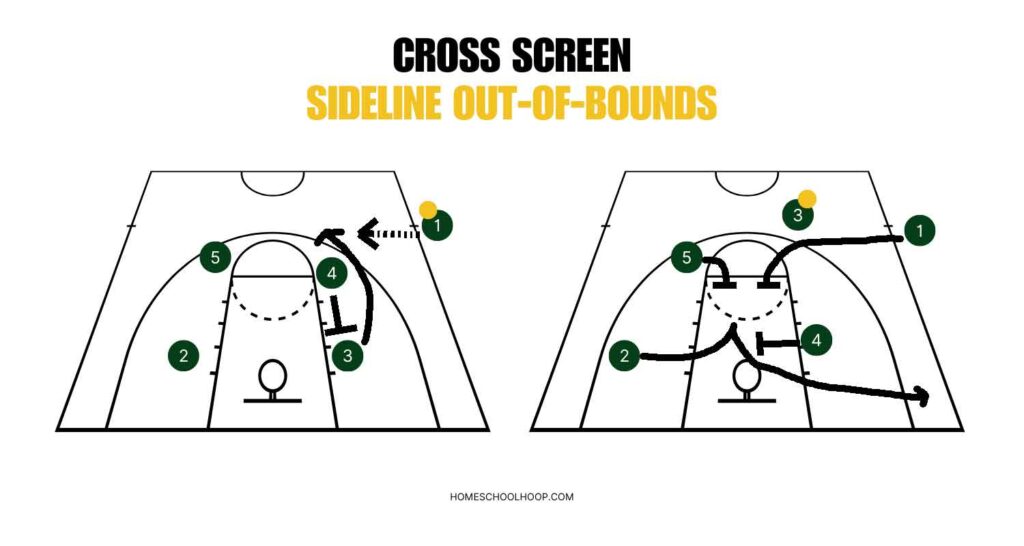Screens play an important role in most basketball offenses and out-of-bounds plays, freeing up a teammate for a shot or to receive a pass. A specific type of screen called the cross screen is designed for creating scoring chances near the low block. This maneuver involves one player setting an off-ball screen across the lane, freeing up a teammate for an easy layup or post-move opportunity.
Key Takeaways:
- A cross screen in basketball happens away from the ball, as one player sets a screen across the key.
- This type of screen creates open space for a player near the low block.
- It’s regularly used in offensive schemes, quick-hitters, and baseline out-of-bounds plays.
Here, we’ll discuss the mechanics of the cross screen in basketball, the strategies for using it, some cross screen plays, and how to counter it when you’re on the defensive end.
Cross Screen Basics
Using a screen in basketball is among the most commonly used ways for teams to boost their offensive strategy. The cross screen is a specific type of screen that plays a role in creating space and scoring opportunities close to the basket.
What is a Cross Screen in Basketball?
A cross screen happens away from the ball. It involves one plate resetting a screen across the key or lane to free up a teammate, usually to get that player open near the basket.
This screening action is typically executed near the low post or middle of the lane, but can also happen at the high post area.
While often a guard sets the screen for a post player to create a mismatch or to get an open shot, two post players can also perform this move.
Why It Works
The cross screen’s effectiveness lies in its ability to hinder a defender just enough to create high-percentage scoring opportunities close to the basket.
It can be effective for:
- Slowing the defense: A quality cross screen disrupts the defender of the cutter, causing them to get out of position or fall a step behind their player.
- Opening up space: This type of screen can momentarily free an offensive player, giving them a clear path to receive a pass for an easy score.
- Creating mismatches: Defenses will often switch players when cross screens happen. If a smaller player (like a guard) sets a screen for a bigger player (like a center), and defenders switch, it can lead to a size mismatch favoring the offense.
- Generating an easy-score opportunity for the screener: If the defenders switch, the player setting the cross screen can roll to pin the defender on their back, creating a passing lane for them to receive the ball on the opposite block.
Cross screens are also often followed with another type of screen in screen-the-screener action. For example, the player who sets the cross screen may receive a down screen from another teammate for them to pop out for an open shot at the high post.

Limitations
While a valuable tool for offenses, the cross screen has its limitations.
It can be hard to get the ball to the offensive player coming off the cross screen. Since the screen usually moves a player a short distance (from one post to another), the window for the offensive player to receive the ball is brief. If the passer is under intense pressure, delivering the ball during that limited window can be challenging.
It’s an easier type of screen to defend. In a cross screen situation, the player being screened is often in an open-stance help position and they can see the screen coming.
The offensive player coming off the screen needs to have a post-move arsenal. When they do get open on the block, their defender will be on their back. This means they’ll need to be able to make a move to get their shot off.
Key Components of Effective Cross Screens
Player Roles
A cross screen involves three offensive players:
- Screener: Usually a guard or a smaller player, the screener’s job is to move across the key to set a solid, well-timed screen to create a path for their teammate.
- Cutter: Typically a post player or something good at scoring near the basket, the cutter reads the defense and uses the screen to cut toward the ball-side block.
- Passer: This is generally a guard or small forward who is a good passer. During a cross screen, they’re usually with the ball at the wing or corner and ready to deliver the ball as soon as the cutter comes open.
For a cross screen to work, the screener, cutter, and passer need to be in sync. All three have to pull off the right mechanics, positioning, and timing to disrupt the defense enough to open space for the cutter.
Positioning and Setup
The screener has to position themselves in a way that maximizes the chances of freeing up their teammate. This involves:
- Location: Ideally, set the screen near the middle of the lane so there’s room at the low block for the cutter to fill.
- Angle: The screener should aim to set the screen at an angle that blocks the defender’s path. The idea is to set yourself a stride away to either force contact or make them go around you.
Timing
Timing is everything with all types of screens, including the cross screen:
- The screener needs to wait until their teammate is in position, across the key from them, to benefit from the screen.
- The cutter should start their cut to the opposite block only after their teammate is in a set position. Too early and they risk setting up their screening teammate for a moving screen foul.
Cross Screen Plays
Cross screens are commonly found in basketball offenses, and used to create scoring opportunities. Let’s break down how a selection of these plays works:
Cross Screen Transition Play
In this play, everything starts with a ball screen to help the point guard get free. Meanwhile, a player on the wing sets a cross screen for a teammate near the basket on the other side. This action aims to get the post player open for a pass and a shot near the basket.

Cross Screen Quick Hitter
This strategy aims to get the ball to a strong player near the basket. It begins with a screen that allows a pass to a player on the wing. Then, the player who just set the initial screen quickly sets another cross screen. This helps a teammate get the ball under the rim for an easy score.

Cross Screen Side Out-of-Bounds Play
From a box formation, this play starts with a screen to get the ball in play near the top of the key. While it looks like two players are setting up for an elevator screen (as a distraction), the real action is happening elsewhere. The player who set the initial screen now sets a cross screen, helping open up a space for a teammate at the far side of the basket, ideally for a three-point shot.

How to Defend Against Cross Screens
Now that you know how cross screens in basketball work, let’s discuss how defenses can counter them.
Defensive Strategies
Defenses have a few options to manage the cross screen in basketball:
- Fight Through the Screen: The defender being screened should stick close to their defender and use quick footwork. Simultaneously, their teammate opens up to create a pathway for them to navigate around the screen.
- Switching: In some cases, defenders may switch assignments to prevent the offensive player coming off the screen from getting open. This option can create a mismatch but may be the best choice for disrupting the play.
- Sagging On-Ball Defense: Knowing the cross screen is coming, the defender on the perimeter player with the ball may sag off into the key. This disrupts the pass into the cutter but leaves the player with the ball open to shoot.
- Help Defense: Nearby defenders should also stay aware. They need to be ready to step over to help if the screened defender gets caught.
Recognizing the Setup
The first step in defending against any screen is recognizing when one is coming. Some key indicators for a cross screen are:
- Positioning: Keep an eye out for offensive players positioning themselves across the lane from each other.
- Player Movement: Notice when a player starts moving toward a position to set a screen, often a guard moving toward the basket area.
Good Communication
Defenders need to talk to each other so they’re on the same page on how to navigate cross screens:
- Call out screens: The player who first sees the screen coming should call it out to their teammate.
- Decide whether to switch or stay: Teammates need to communicate their decision on whether to switch defenders or stay with the original assignments.
FAQs
What is a cross screen?
A cross screen is where one player sets a screen for a teammate across the key or lane. It’s usually designed to create a scoring opportunity close to the basket.
What is a cross play in basketball?
A cross play in basketball refers to an offensive strategy that incorporates a cross screen. It involves players screening across the key, often leading to an open shot or a mismatch near the basket.
SHARE YOUR OPINIONS
Today, you learned about the cross screen in basketball.
So we want to know: What are your thoughts on the effectiveness of cross screens? Do you think they’re an essential part of the team’s offensive strategy?
Let us know in the comments.

